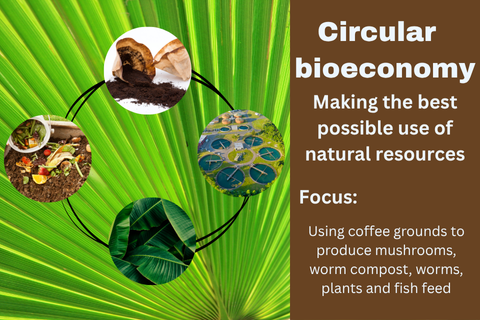Circular bioeconomy: using coffee grounds to produce mushrooms, worm compost, worms, plants and fish feed
The bioeconomy is a hot topic these days, right up at the top of policy agendas. It involves using renewable natural resources as a raw material. The circular bioeconomy introduces circularity into this concept: using what would otherwise be thrown away, using spent biological resources to regenerate ecosystems and minimising waste.
The ECESP website has a good selection of circular bioeconomy-themed content. This series will shine a spotlight on it.
Circular bioeconomy concept: how coffee grounds can be used to produce mushrooms, worm compost, worms, plants and fish feed
Funghi Espresso is an innovative business in Italy that produces fresh mushrooms in a sustainable and natural way, using coffee grounds (coffee waste) from local bars and restaurants as a growing medium.
The Funghi Espresso model:
- The cycle starts with the coffee grounds, which are collected from the bars of Tuscany.
- The coffee grounds are used with coffee silver skin, another coffee byproduct, to produce an ideal substrate for growing oyster mushrooms.
- Once the mushrooms have grown, the exhausted substrate is regenerated through worm composting, yielding earthworm humus and earthworms.
- The humus is used as an organic soil improver and the earthworms are used as fish feed.
- Water containing fish waste can be used for hydroponic vegetable cultivation.
Results
- The Funghi Espresso model uses an organic waste to produce mushrooms, worm compost, worms, plants and fish feed.
- Funghi Espresso also organises educational and training courses for schools and training on the job to replicate the model.
- You can buy mushrooms and growing kits from their webshop.

